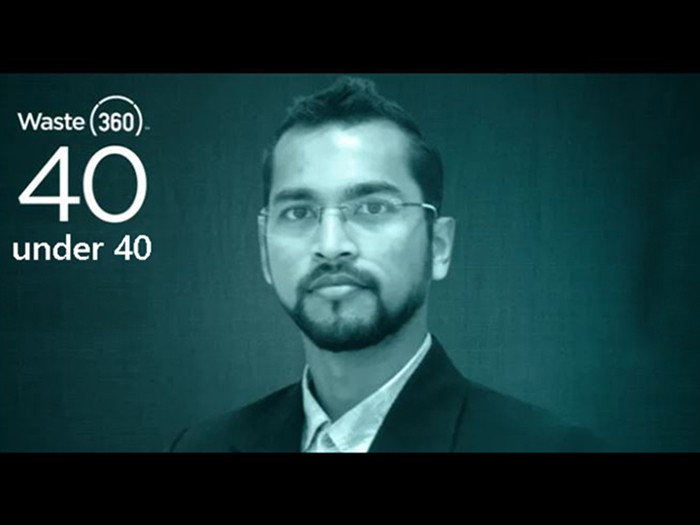


These young professionals, recognized in the environmental industry as rising stars, are making a difference. The 40-U-40 program introduces us to inspiring and innovative professionals under 40 who have made significant contributions through their work in waste, recycling, food waste, and organics. These environmental solutions provide proven and substantial positive impacts in lowering carbon footprints and helping us reach sustainable goals toward carbon neutrality.
Ketan Shah is a dedicated waste industry professional who focuses on technology solutions to lower environmental and health risks while looking to improve efficiency. Shah is an expert in landfill gas recovery modeling, refuse transfer station design, and life cycle assessment modeling. His contributions as a scholar and practitioner to environmental advancement are undeniable due to his published research and award-winning projects.
Dr. Shah’s impact on the waste management industry is ongoing, making him a great asset to SCS, its clients, and the community. Waste 360’s slideshow shows all the 2024 Awardees.
Cited Publications:
The ABA Annual Spring Conference on Environmental Law, April 3-5 in Chicago, IL., is where you join leading environmental, energy, and resources law professionals for knowledge-sharing, networking, and inspiration in the Windy City. The conference provides timely, topical updates on the latest opportunities and challenges facing the field of environmental law, with a deep dive into the fields of environmental compliance, energy, and resources law. Join – SEER – the Section of Environment, Energy, and Resources, to learn about the latest developments shaping the practice today and the long-term trends that will drive the future.
What to Expect
Lively discussions with leading practitioners, including state and federal regulators, leading scholars, and in-house counsel. Each day will kick off with a plenary session diving into key topics: one on forthcoming Supreme Court decisions that could reshape environmental law, and one on the evolution of EPA’s enforcement tools. A special track of panels will focus on the challenges of regulating across multiple jurisdictions. Panels in this series will help attendees understand how state priorities shape Clean Air Act and Clean Water Act implementation, parse through competing frameworks steering the energy transition, and make sense of global ESG trends influencing U.S. policy. The conference will also feature a litigation workshop focused on cutting-edge strategies for using unique types of evidence, like Indigenous Knowledge, in the courtroom.
Panels will examine liability mechanisms for historical PFAS, explore how regulatory pathways for emerging contaminants will impact clients, and consider practical approaches to environmental justice through the lens of a real case study in Chicago. Top speakers will weigh in on balancing the energy transition against national security and the ethical implications of artificial intelligence for lawyers. In addition to insights and practice tips from top practitioners, two panels will begin with case summary presentations by law students and young attorneys that attendees can use in their own practices.
Whether you are an experienced practitioner or in the beginning stages of your practice, join us in Chicago to create new connections, exchange perspectives, and get inspired by your fellow environmental, energy, and resources law professionals.

Mergers and Acquisitions Due Diligence Trends
In the realm of Mergers and Acquisitions (M&A), environmental due diligence is a pivotal aspect, essential for evaluating potential risks, liabilities, and costs, and ensuring adherence to environmental laws and regulations. This diligence profoundly affects transaction valuation, structuring, and negotiation.
The key to this process is verifying compliance with environmental regulations at target facilities, which encompass local, regional, and national laws and standards related to pollution, waste management, resource use, and other environmental aspects.
Conducting All-Appropriate Inquiries (AAI) is vital for assessing a property’s environmental conditions and potential contamination liabilities. Under CERCLA 101(35)(B), following established commercial and customary standards, these inquiries are crucial for certain CERCLA liability defenses, including bona fide prospective purchaser, innocent landowner, and contiguous property owner defenses. These defenses require the landowner to demonstrate AAI completion before property acquisition.
Environmental regulations like CERCLA can extend liability beyond the actual facility or business owner, potentially impacting lenders in certain scenarios. Entities acquiring contaminated property are liable for remediation, regardless of their role in the contamination. While they can seek indemnity or contribution from former owners, authorities can still hold the current owner accountable.
Evaluating potential liabilities from waste generation and disposal, both current and historical, is critical. This includes considering future regulatory actions, adhering to continuing obligations related to ongoing cleanup or monitoring, cleanup costs, and potential legal conflicts or penalties.
In share purchases, buyers typically inherit all environmental liabilities of the corporate target. Conversely, asset purchases may allow acquiring assets without inheriting certain liabilities, especially those linked to historical issues.
Environmental liabilities can significantly affect deal valuation. Buyers may negotiate lower prices or specific indemnities for significant environmental risks, while strong compliance records can enhance value.
Mergers and Acquisitions in Industry and Manufacturing
Due to higher inherent environmental risks, industries like manufacturing, chemicals, and energy necessitate more thorough environmental assessments. Furthermore, even though operational aspects of these facilities may not represent likely sources of contamination, they may still present the threat of future release if they are not well managed and have business risks related to regulatory noncompliance. Features such as air permitting and wastewater management are important to consider, as large fines or even temporary injunctions against one or more processes can result in a significant financial burden.
Environmental insurance products can manage risks identified during due diligence, providing a safety net against unexpected liabilities.
In bankruptcy transactions, unique environmental issues arise. Claims like ongoing noncompliance and remediation obligations often persist post-transaction.
A crucial aspect often overlooked is the requirement of regulatory approvals for some M&A transactions, which the environmental records of the companies involved can significantly influence. In today’s environmentally conscious world, the public perception of a company’s environmental stewardship, especially in environmentally sensitive industries, can greatly impact the success or failure of a merger or acquisition. This public image aspect necessitates a careful and proactive approach to environmental due diligence, aligning with regulatory standards and societal expectations.
A Sustainable Approach to Mergers and Acquisitions
As environmental justice, climate change, and sustainability become more central, the M&A approach is evolving. Companies are now scrutinized for their alignment with sustainable practices, including their carbon emissions, energy efficiency, and overall impact on climate. This scrutiny isn’t limited to their current practices but also encompasses future potential, especially for companies possessing cutting-edge green technologies or sustainable methods, as these can offer significant competitive advantages in the market. Furthermore, a critical consideration is the impact of a company’s operations on local communities, particularly in areas identified as disadvantaged and more prone to environmental hazards. The U.S. Environmental Protection Agency is placing greater emphasis on monitoring these areas. Therefore, companies involved in M&A must be aware of the importance of community engagement and building positive relationships with residents and officials, especially in these vulnerable areas.
In summary, environmental considerations in M&A go well beyond mitigating risks; they increasingly focus on leveraging opportunities for sustainable growth and aligning with evolving global environmental trends. These considerations necessitate a broader, more comprehensive approach to environmental due diligence, incorporating regulatory, public perception, and strategic planning for post-acquisition integration and sustainable growth.
Additional Resources:
Join SCS Engineers with the CCIM Institute: San Diego Chapter for an enriching evening of networking, insights, and Happy Hour at the Bali Hai Restaurant on Thursday, March 14, 2024, from 3-6 p.m.
Don’t miss the opportunity to hear from our very own Cristobal Ramirez, who will share valuable insights and expertise during the event. The panel will address a range of topics including legal, entitlement, and zoning considerations, overcoming environmental obstacles, and navigating architectural complexities. Will also be highlighting successful projects while exploring cost factors, common construction challenges, and pertinent case studies that illuminate the path forward.
The CCIM San Diego Chapter event offers a unique platform to connect, learn, and thrive. Mark your calendars and join us for an evening of education, networking, and inspiration. We look forward to seeing you there!

Using a computer, iPad, or cell phone landfills and renewable energy plants can diagnose and balance wellfields faster and more efficiently. Office and field stay in touch 24/7, shortening compliance time. This week, SCS Field Services demonstrates how it works – in a monthly educational forum open to landfill and landfill gas management, renewable energy staff, and agencies.
Liquid Level Diagram Report to Improve LFG Extraction – By viewing the real-time relationships between liquids accumulated in landfill gas extraction wells and the perforated portion of the wells, your data shows how liquids impact well perforations, which can reduce, restrict, or prohibit landfill gas extraction. You’ll see well profiles, where the liquids are, if they’re potentially impacting perforations, how much solid pipe is on the well, and where the current liquid elevation is within the well in relation to the amount of perforated pipe.
SCS MobileTools – is a portable version of SCS DataServices, which provides data access while the technician conducts field measurements in the wellfield. Technicians can access their historical wellfield data from their smartphone or smart tablet. As the technician progresses through monitoring, the project team gets updates while the data is being collected in the field. SCS MobileTools uploads the data into DataServices, generating updated information like the Liquid Level Diagram Report for the project team.
6-Month Wellfield Data Review Report to Gauge Actions to Results – The Report illustrates wellfield performance over the previous six-month period for the different parameters that owners and operators value. Wellfield trends and progress show at a glance if methane is up, oxygen is down, the balance gas is down, or the flow per well is up. Are you losing the vacuum on any wells? It also provides a visual snapshot assessment of your most current month’s data and is useful to demonstrate if field actions are getting the desired results.
Exceedance Tracking and Exceedance Manager for Compliance Actions – Addressing NSPS exceedances or similar issues is already available in SCS DataServices. The Exceedance Manager details closeouts and actions for state and federal compliance reporting. As your staff works, it builds a record for responding to NSPS, OOO, XXX, and NESHAP Quad A reporting.
So whether you use an air consultant on an individual facility or manage multiple facilities, your staff can get the documented reason of how an exceedance was closed up and exactly when meeting crucial timelines of five days, 15 days, 60 days, 75 days, and 120 days. It provides a good compliance record for the supporting air consultant and regulatory authority.
SCS Surface Emissions Module – SCS has added a Surface Emissions module for uploading, reviewing, and tracking SEM exceedances. Having all of your wellfield and NSPS compliance data in one place provides landfill compliance personnel with peace of mind that all of the data has been captured and is being stored and managed in a single location, while providing easy access to other pertinent wellfield data. We’ll also show you how the Surface Emissions Monitoring features with an Exceedance Manager document NSPS exceedance tracking and cleanup for surface emissions monitoring events.

Reduce labor hours and shorten compliance timelines by reviewing wellfield data from your GCCS. Our SCS Field Services panelists demonstrate how to transform wellfield data into critical and actionable information.
Liquid Level Diagram Report to Improve LFG Extraction – By viewing the real-time relationships between liquids accumulated in landfill gas extraction wells and the perforated portion of the wells, your data shows how liquids impact well perforations, which can reduce, restrict, or prohibit landfill gas extraction. You’ll see well profiles, where the liquids are, and if they’re potentially impacting perforations, how much solid pipe is on the well, and where the current liquid elevation is within the well in relation to the amount of perforated pipe.
SCS MobileTools – is a portable version of SCS DataServices, which provides data access while the technician conducts field measurements in the wellfield. Technicians can access their historical wellfield data from their smartphone or smart tablet. As the technician progresses through monitoring, the project team gets updates while the data is being collected in the field. SCS MobileTools uploads the data into DataServices, generating updated information like the Liquid Level Diagram Report for the project team.
6-Month Wellfield Data Review Report to Gauge Actions to Results – The Report illustrates wellfield performance over the previous six-month period for the different parameters that owners and operators value. Wellfield trends and progress show at a glance if methane is up, oxygen is down, the balance gas is down, or the flow per well is up. Are you losing the vacuum on any wells? It also provides a visual snapshot assessment of your most current month’s data and is useful to demonstrate if field actions are getting the desired results.
Exceedance Tracking and Exceedance Manager for Compliance Actions – Addressing NSPS exceedances or similar issues is already available in SCS DataServices. The Exceedance Manager details closeouts and actions for state and federal compliance reporting. As your staff works, it builds a record for responding to NSPS, OOO, XXX, and NESHAP Quad A reporting.
So whether you use an air consultant on an individual facility or manage multiple facilities, your staff can get the documented reason of how an exceedance was closed up and exactly when meeting crucial timelines of five days, 15 days, 60 days, 75 days, and 120 days. It provides a good compliance record for the supporting air consultant and regulatory authority.
SCS Surface Emissions Module – SCS has added a Surface Emissions module for uploading, reviewing, and tracking SEM exceedances. Having all of your wellfield and NSPS compliance data in one place provides landfill compliance personnel with peace of mind that all of the data has been captured and is being stored and managed in a single location, while providing easy access to other pertinent wellfield data. We’ll also show you how the Surface Emissions Monitoring features with an Exceedance Manager document NSPS exceedance tracking and cleanup for surface emissions monitoring events.
Join SCS Engineers at the 39th Annual Northwest Regional Symposium!
The Beaver Chapter of SWANA is happy to announce the return of the 39th Annual Northwest Regional Symposium, taking place May 1st – May 3rd, 2024, at the historic McMenamins Edgefield in Troutdale, Oregon. This years theme is Innovation: Shaping the Future of Materials Management.
Throughout the Symposium, participants will be able to engage in discussions, collaborative sessions, and hands-on workshops aimed at driving positive change and fostering innovation in the field of materials management. From exploring emerging technologies to addressing environmental challenges, the Symposium provides a holistic perspective on the evolving landscape of waste management and sustainability.
Whether you’re a seasoned veteran or new to the field, this symposium offers invaluable insights, resources, and opportunities to stay ahead of the curve. Don’t miss this opportunity to be part of a transformative experience in materials management!
Click here for more information and registration details.
Join SCS Engineers at the 2024 Food and Beverage Environmental Conference on April 16-19! The conference will be held at Hotel Effie in Miramar Beach, FL.
The 2024 Food and Beverage Environmental Conference (FBEC) is a premier gathering for environmental professionals in the food and beverage industry nationwide. Discover the latest trends in sustainability, water management, supply chain dynamics, air quality, environmental compliance, and professional development.
At the Food and Beverage Environmental Conference, delve into an array of topics crucial to environmental stewardship in the food and beverage sector. From craft breweries to pet food manufacturers, grocery stores, and stakeholders in nutrition, farming, and processing, explore the entire industry spectrum. Join us for insightful discussions and networking opportunities.
Click here for schedule, registration, and other conference details.
Join SCS Engineers at the 2024 Food and Beverage Environmental Conference on April 16-19! The conference will be held at Hotel Effie in Miramar Beach, FL.
The 2024 Food and Beverage Environmental Conference (FBEC) stands as the premier gathering for environmental professionals within the food and beverage industry across the United States. This event serves as a pivotal platform for exploring the latest trends and innovations influencing sustainability, water resource management, supply chain dynamics, air quality enhancement, environmental compliance, and professional development.
At the conference, attendees will be able to delve into a diverse array of topics crucial to environmental stewardship in the food and beverage sector. From craft breweries and distilleries to pet food manufacturers, grocery stores, and stakeholders involved in nutrition, farming, processing, transportation, distribution, and supply chain management, the Food and Beverage Conference encompasses the entire spectrum of industry involvement.
For more information and registration click here!

Organics diversion is a hot topic, highlighting the need for more recycling to help communities benefit from methane emission reductions and decarbonization. Methane emissions from organic waste, such as food and plants, are largely preventable and comprise a significant portion of the U.S. waste stream. That makes actions to reduce these emissions popular, such as diverting waste from landfills, establishing recycling and composting programs, and energy recovery from organic materials – they create social and economic opportunities. At the same time, the programs make significant progress toward climate action goals.
Federal Grant Funding
The U.S. government has grant funding available to assist state and local government and non-profit organizations in increasing organic diversion. Currently, several agencies and departments have grants available. These are the U.S. Environmental Protection Agency (EPA), the U.S. Department of Agriculture (USDA), and the U.S. Department of Energy (DOE).
Finding the Right Grant
ReFED has partnered with the Natural Resources Defense Council to develop a Federal Grants Database to provide a centralized place to identify funding. The Resources and Guides | ReFED database provides the grant name, the agency, a description, the deadlines, the eligibility, a link to the grant, and other useful information.
EPA’s current grant programs are:
At least eight of the SWIFR grants are organics-related, and the communities that are taking advantage of them are as follows:
More details on each of these projects are here.
EPA also has the Climate Pollution Reduction Grants that the states and other regional authorities will administer. The states and regional authorities are developing their implementation plans for these grants. SCS Engineers expects food scrap and composting projects to be some of the many projects eligible for these grants.
DOE has two grant programs:
USDA has several grant opportunities related to food waste, including:
In January, the USDA announced an investment of approximately $11.5 million in 38 cooperative agreements that support innovative, scalable waste management plans to reduce and divert food waste from landfills. The Composting and Food Waste Reduction cooperative agreements, which the American Rescue Plan Act funds, are part of USDA’s broad support for urban agriculture.
Among the projects, the Southeastern Connecticut Regional Resources Recovery Authority proposes to construct and operate southeastern Connecticut’s first and only commercial-scale food waste composting facility, creating the necessary infrastructure to divert the region’s organic material from the municipal solid waste stream, generate a local source of high-quality compost, and increase awareness of the importance of food waste reduction and recycling. SCS assisted with the design and permitting of this project.
The USDA’s Fertilizer Production Expansion Program (FPEP) provides grants to help eligible applicants increase or expand the manufacturing and processing of fertilizer and nutrient alternatives in the United States. The Compost Crew in Maryland has received tentative notice of funding for a new compost facility. SCS assisted with the design of this project.
For States and Communities Getting Started
Historically, feasibility studies and pilot programs make excellent first steps toward decarbonization, recycling, composting, and zero waste programs. Many states and communities start with waste composition and feasibility studies or pilot programs.
Truly sustainable programs balance economic, environmental, and social factors to ensure they work long-term and comply with grant terms. These services are available from reputable sustainable materials management engineers and consultants who understand all aspects of solid waste management and federal and local air, water, and soil regulations.
Additional Resources:
 About the Author: Dana Murray Blumberg, PE, is SCS Engineers’ Vice President for International Services and our National Expert on Federal Services. She has three decades of professional experience in civil/environmental engineering, including landfill gas emissions modeling and collection system design; landfill gas energy technology evaluation, feasibility analysis, energy user outreach and analysis; landfill closures; transfer station design and construction; and stormwater hydrology and hydraulics.
About the Author: Dana Murray Blumberg, PE, is SCS Engineers’ Vice President for International Services and our National Expert on Federal Services. She has three decades of professional experience in civil/environmental engineering, including landfill gas emissions modeling and collection system design; landfill gas energy technology evaluation, feasibility analysis, energy user outreach and analysis; landfill closures; transfer station design and construction; and stormwater hydrology and hydraulics.